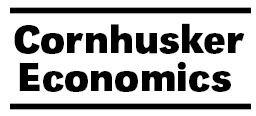Agricultural Economics, Department of

Cornhusker Economics
Date of this Version
7-31-2019
Document Type
Newsletter Issue
Citation
agecon.unl.edu/cornhuskereconomics
Abstract
The Western Corn Belt has historically been corn and wheat cropping systems with cattle integrated on nearby grasslands. Recent agricultural production data ranked Nebraska, South Dakota, Kansas, and North Dakota in the top 10 states for both corn and beef cattle production in the United States. In 2017, these four states had about 20% of the beef cow inventory in the United States with Nebraska alone having 1.9 million beef cows (USDA National Agricultural Statistics Service, 2018). Forage-based livestock production is a fundamental component of these agricultural economies. However, a large quantity of grasslands in this region were converted into annual crops during the mid-2000s (Wright and Wimberly, 2013). To maintain the efciencies of beef cattle production systems, synergistic use of forage resources in a sustainable manner is essential. In addition to grasslands, this includes the complementary use of corn residue for grazing during the winter months. In this article, we provide an economic assessment of current corn residue grazing in Nebraska as well as some comparisons to Kansas, South Dakota, and North Dakota.

